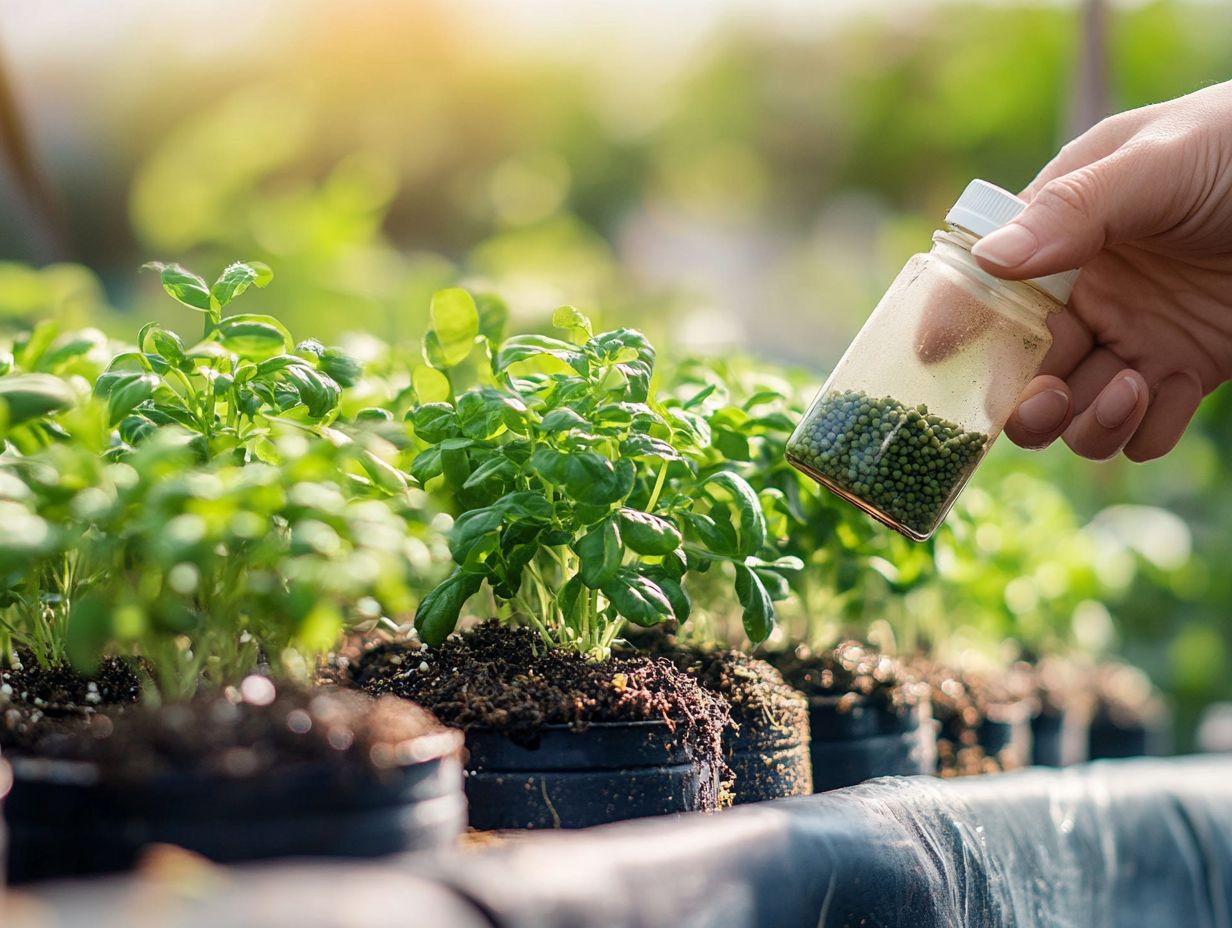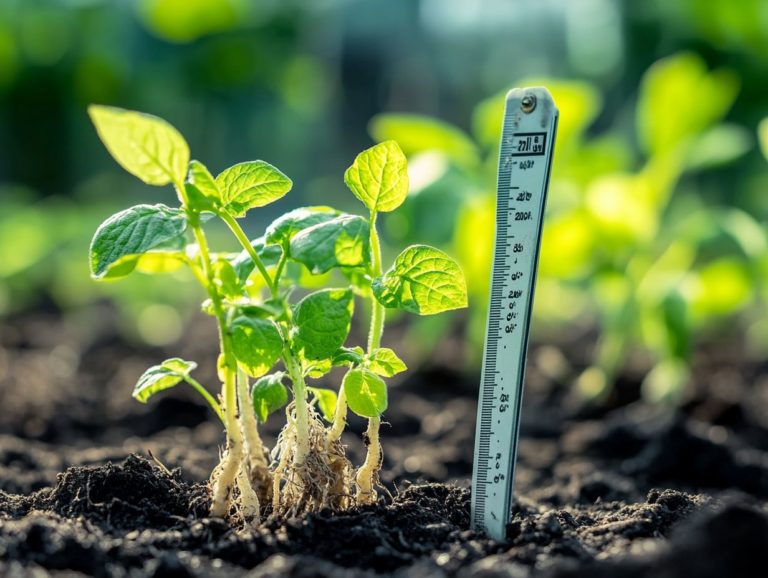The Role of Magnesium in Hydroponics
Hydroponics is revolutionizing the way you cultivate plants, providing a soil-free approach that maximizes both efficiency and yields.
Among the key nutrients essential for healthy plant growth, magnesium stands out as a critical component. It plays a vital role in processes like photosynthesis and significantly impacts overall plant health and development.
In this article, you’ll discover the functions of magnesium, how to identify magnesium deficiency in hydroponic systems, and best practices for maintaining optimal magnesium levels to ensure robust plant growth.
Learn how to boost your indoor hydroponic setup for amazing results!
Contents
- Key Takeaways:
- Functions of Magnesium in Plants
- Symptoms of Magnesium Deficiency in Hydroponics
- Sources of Magnesium for Hydroponic Systems
- Optimizing Magnesium Levels in Hydroponics
- Frequently Asked Questions
- What is the role of magnesium in hydroponics and why is it important?
- How does magnesium deficiency affect plants in hydroponics?
- How can I ensure my hydroponic plants receive enough magnesium?
- Are there any natural sources of magnesium for hydroponic plants?
- What are the benefits of using magnesium in hydroponics?
- Can excessive levels of magnesium be harmful to hydroponic plants?
Key Takeaways:

- Magnesium is crucial for hydroponic plant health.
- Timely identification of magnesium deficiency boosts plant productivity.
- Choose the right magnesium supplement for best results.
What is Hydroponics and Why is Magnesium Important?
Hydroponics is an innovative agricultural method that allows you to grow plants in a nutrient solution without using soil, making it essential for maximizing both plant health and yield. This soilless method allows you to precisely manage nutrient levels, especially magnesium, which plays a crucial role in various physiological functions within your plants.
Magnesium is a vital component of chlorophyll pigment, essential for photosynthesis. It also supports effective nutrient absorption and root growth.
The precision in nutrient delivery with hydroponics enhances your plants’ vitality and significantly reduces the risk of soil-borne diseases that often plague traditional farming systems. Hydroponics is a sustainable solution that facilitates water conservation and minimizes environmental impacts.
Integrating magnesium into your nutrient regimen can further optimize crop production, leading to robust plant development and improved fruit quality. You can yield higher quantities of healthy produce, meeting the increasing demand for fresh, nutrient-dense foods, all while positively contributing to eco-friendly agriculture.
Functions of Magnesium in Plants
Magnesium stands as a cornerstone in plant biology, vital for numerous essential functions. It plays a key role in chlorophyll synthesis and enzyme activation, both of which significantly impact nutrient absorption and the overall health of your plants.
Key Roles in Plant Growth and Development
The essential roles of magnesium in plant growth and development are truly remarkable. It significantly impacts nutrient uptake and serves as a vital component of chlorophyll, critical for photosynthesis.
This crucial mineral acts as a cofactor for various enzymatic reactions fundamental to energy production, particularly in converting sunlight into chemical energy. Without adequate magnesium, your plants may struggle to produce chlorophyll effectively, resulting in poor photosynthetic efficiency and stunted growth.
In hydroponic systems, magnesium is critical for optimizing the uptake of other essential nutrients, allowing your plants to absorb potassium and calcium with greater efficiency. Understanding the role of nitrogen in hydroponic growth is also vital, as its presence fosters overall plant health and enhances resistance to diseases and environmental stress, ultimately promoting vigorous development and impressive yields.
Symptoms of Magnesium Deficiency in Hydroponics

Magnesium deficiency in hydroponics can reveal itself through a range of symptoms that may greatly affect your plants’ health and yield. It’s essential for you, as a grower, to recognize and address these nutrient deficiencies promptly to ensure optimal growth.
Start monitoring your magnesium levels today for healthier plants and higher yields!
Identifying and Addressing Deficiency
Identifying magnesium deficiency in your plants is crucial for keeping them healthy. You can effectively address this issue using methods like Epsom salt and magnesium-rich foliar sprays.
You ll often start recognizing the signs of deficiency through visual cues, such as yellowing between leaf veins. This is a clear indicator of insufficient magnesium levels. To gain a precise understanding of your plants’ nutrient status, consider conducting soil tests or utilizing tissue tests. These methods allow for timely and informed interventions.
Effective treatments include applying Epsom salt, which dissolves into magnesium sulfate. This form is easily absorbable by your plants. Foliar sprays also play a vital role, delivering magnesium directly to the leaves for quick absorption.
These methods quickly restore magnesium, helping your plants grow strong and healthy. By monitoring magnesium levels, you can ensure your plants flourish, ultimately leading to a more bountiful harvest.
Sources of Magnesium for Hydroponic Systems
Ensuring an adequate supply of magnesium in hydroponic systems is crucial for promoting healthy plants. This can be accomplished by utilizing magnesium-rich solutions that enhance your nutrient management.
Types of Magnesium Supplements and Their Effectiveness
There are several types of magnesium supplements you can choose for your hydroponic systems, including Epsom salt and magnesium sulfate. Each has its unique effectiveness in tackling magnesium deficiencies.
These supplements differ in their chemical makeup and how quickly they dissolve. For instance, Epsom salt, made up of magnesium sulfate heptahydrate, is popular thanks to its rapid solubility and straightforward application.
Other alternatives, such as magnesium nitrate and magnesium chloride, offer distinct benefits and can be advantageous in specific nutrient solutions. By understanding these magnesium types, you can tailor your nutrient strategies effectively.
This ensures your plants receive adequate magnesium levels crucial for photosynthesis, magnesium uptake, and overall vitality.
Optimizing Magnesium Levels in Hydroponics

Optimizing magnesium levels in hydroponics is essential for maintaining plant health. It requires effective nutrient management strategies that consider pH fluctuations and ensure balanced nutrient ratios.
By addressing these factors, you can significantly enhance the vitality of your plants and maximize their growth potential.
Best Practices for Maintaining Adequate Magnesium Levels
Implementing best practices to maintain magnesium levels in your hydroponic systems is key for promoting healthy plant growth and preventing nutrient imbalances. Ensuring your plants receive the right concentration of this vital mineral can greatly enhance their overall vitality and yield.
One effective strategy is to regularly test your nutrient solution using reliable monitoring techniques to gauge magnesium levels accurately. By incorporating magnesium-rich supplements like Epsom salt or magnesium nitrate into your nutrient mix, you can swiftly tackle any deficiencies. Additionally, understanding the role of sulfur in hydroponics can further enhance your plant’s health.
Keep an eye out for signs of magnesium deficiency, such as yellowing between leaf veins. This awareness lets you make timely adjustments to your feeding regimen. It s also important to check the pH of your solution. Maintaining an ideal range between 5.5 and 6.5 improves nutrient availability, ensuring your plants thrive.
Use these tips to help your plants thrive for a bigger harvest!
Summary of Key Points and Future Considerations
Understanding the importance of magnesium in hydroponics is crucial for your success in crop production. As you look ahead, exciting new strategies await! Innovative approaches to nutrient management that address magnesium stress should be at the forefront of your strategy.
This essential element plays an important role in photosynthesis and overall plant health, making its inclusion in nutrient solutions critical. As you strive to optimize your hydroponic systems, it’s vital to explore the balance of magnesium with other key nutrients. For a deeper understanding, consider the role of micronutrients in hydroponics. This ensures that your plants receive the right amounts for robust growth.
Emerging technologies, such as automated nutrient monitoring the use of technology to continuously check nutrient levels and customized nutrient blends, have the potential to revolutionize magnesium management. Precision and sustainable practices can greatly improve your results. By addressing these factors, act now to boost your yield quality and resilience in an ever-evolving agricultural landscape.
Frequently Asked Questions
What is the role of magnesium in hydroponics and why is it important?

Magnesium plays a crucial role in hydroponic systems, where its importance cannot be overstated. It is essential for plant growth and development, being a key component of chlorophyll, the molecule responsible for photosynthesis. It also aids in the absorption of other important nutrients.
How does magnesium deficiency affect plants in hydroponics?
A deficiency of magnesium can lead to stunted growth, yellowing of leaves, and reduced chlorophyll production in plants. These signs of deficiency can ultimately affect the overall health and productivity of your hydroponic plants.
How can I ensure my hydroponic plants receive enough magnesium?
In a hydroponic system, magnesium can be supplied through nutrient solutions or by adding magnesium-rich nutrients such as Epsom salt to the reservoir. It is important to regularly monitor the magnesium levels and adjust accordingly to prevent nutrient deficiencies.
Are there any natural sources of magnesium for hydroponic plants?
Yes, there are a few natural sources of magnesium that can be used in hydroponic systems, including magnesium sulfate, dolomite lime, Epsom salts, and kelp meal. However, it is important to carefully measure and control the amount of magnesium from these sources to avoid nutrient imbalances and over-fertilization.
What are the benefits of using magnesium in hydroponics?
Aside from being essential for plant growth, magnesium also helps with enzyme production, improves nutrient absorption, and aids in regulating pH fluctuations in the root zone. It promotes overall plant health and can result in better quality yields, particularly in crops like tomato and cucumber plants.
Can excessive levels of magnesium be harmful to hydroponic plants?
Yes, too much magnesium can lead to magnesium excess and toxicity in plants, causing nutrient imbalances. This can manifest as yellowing or browning of leaves, reduced growth, and even death of the plant. It is important to carefully monitor and maintain appropriate magnesium levels in your hydroponic system to prevent magnesium stress.
Implement these strategies in your hydroponic systems for improved growth and productivity!






